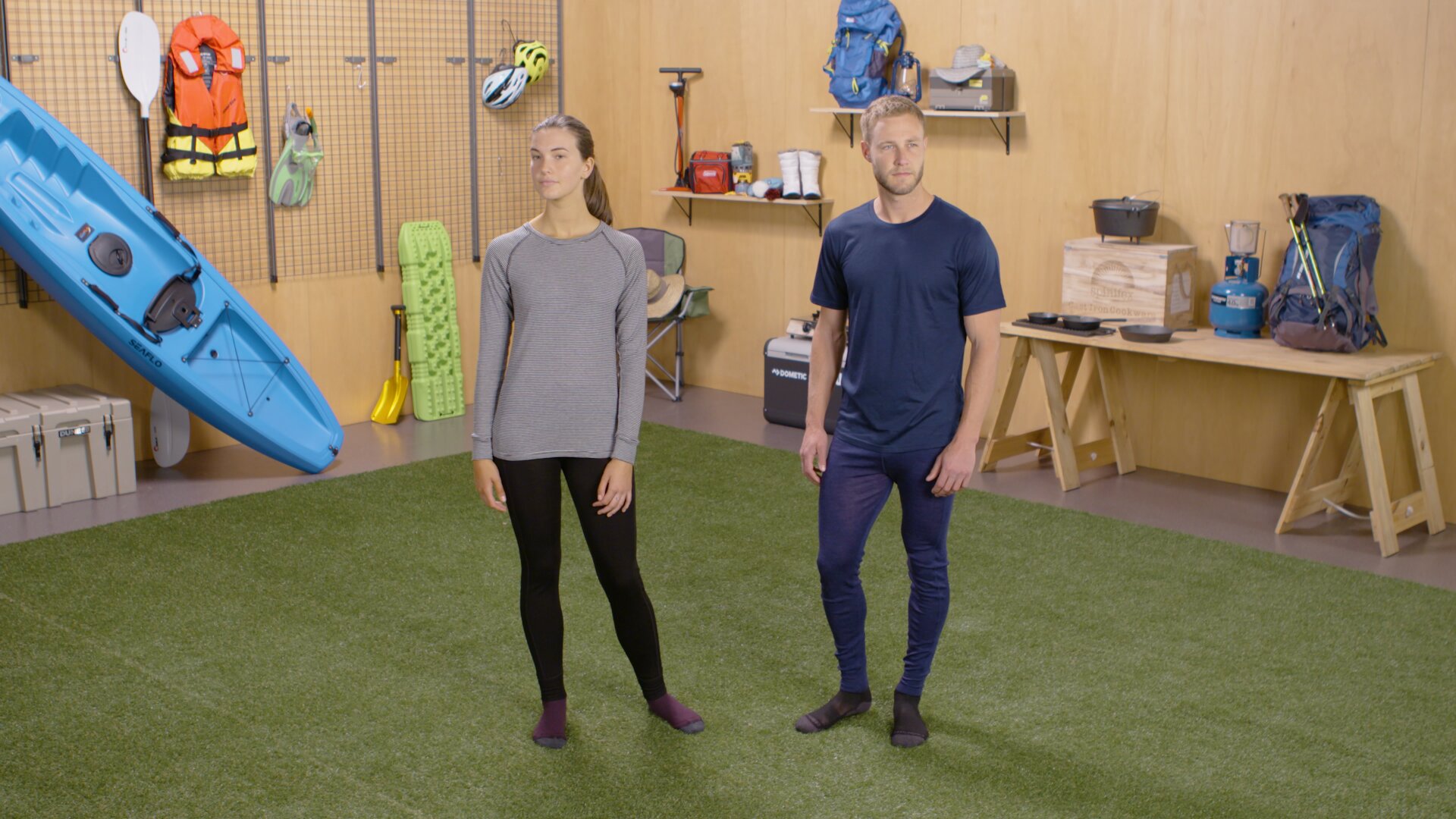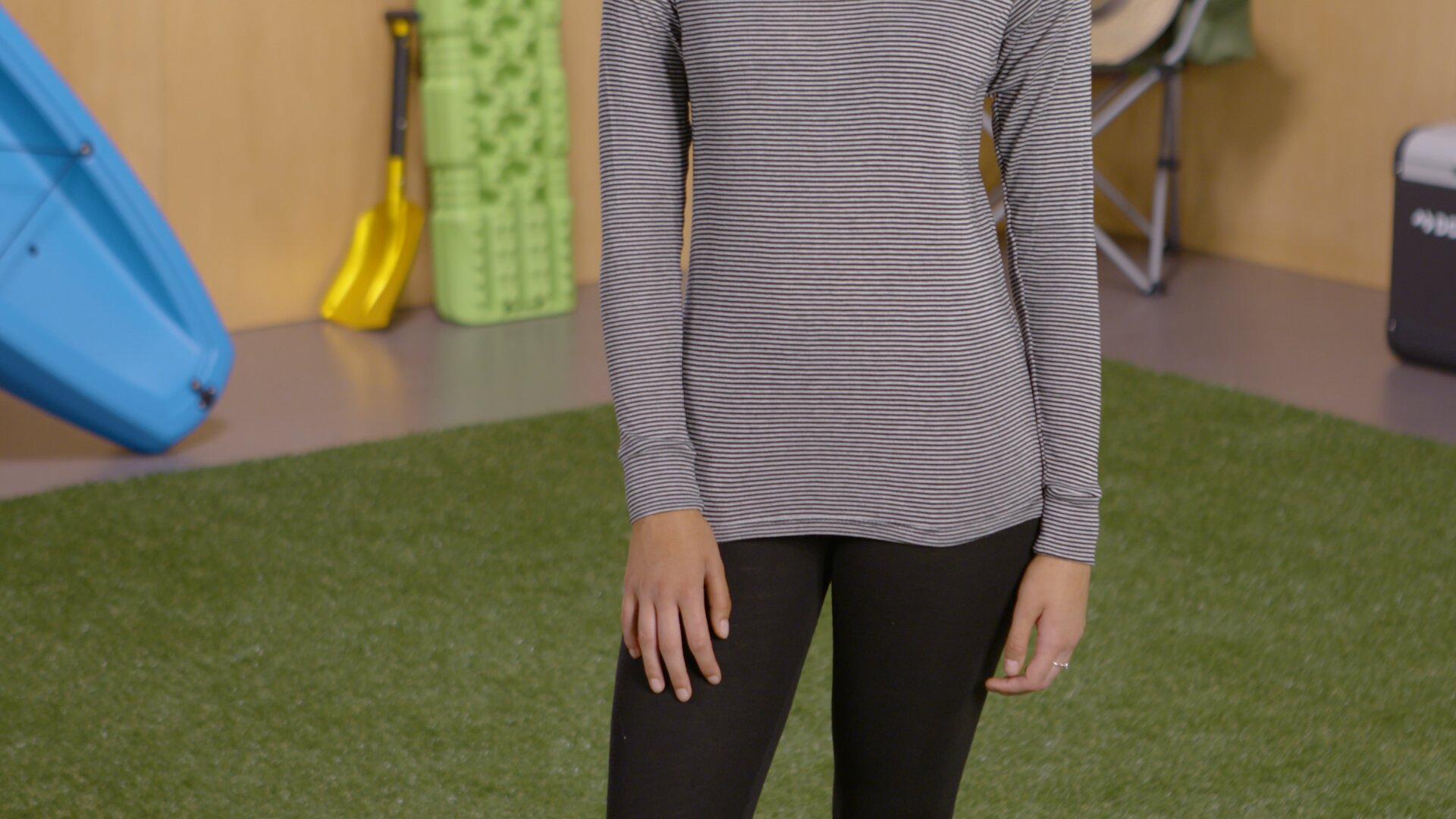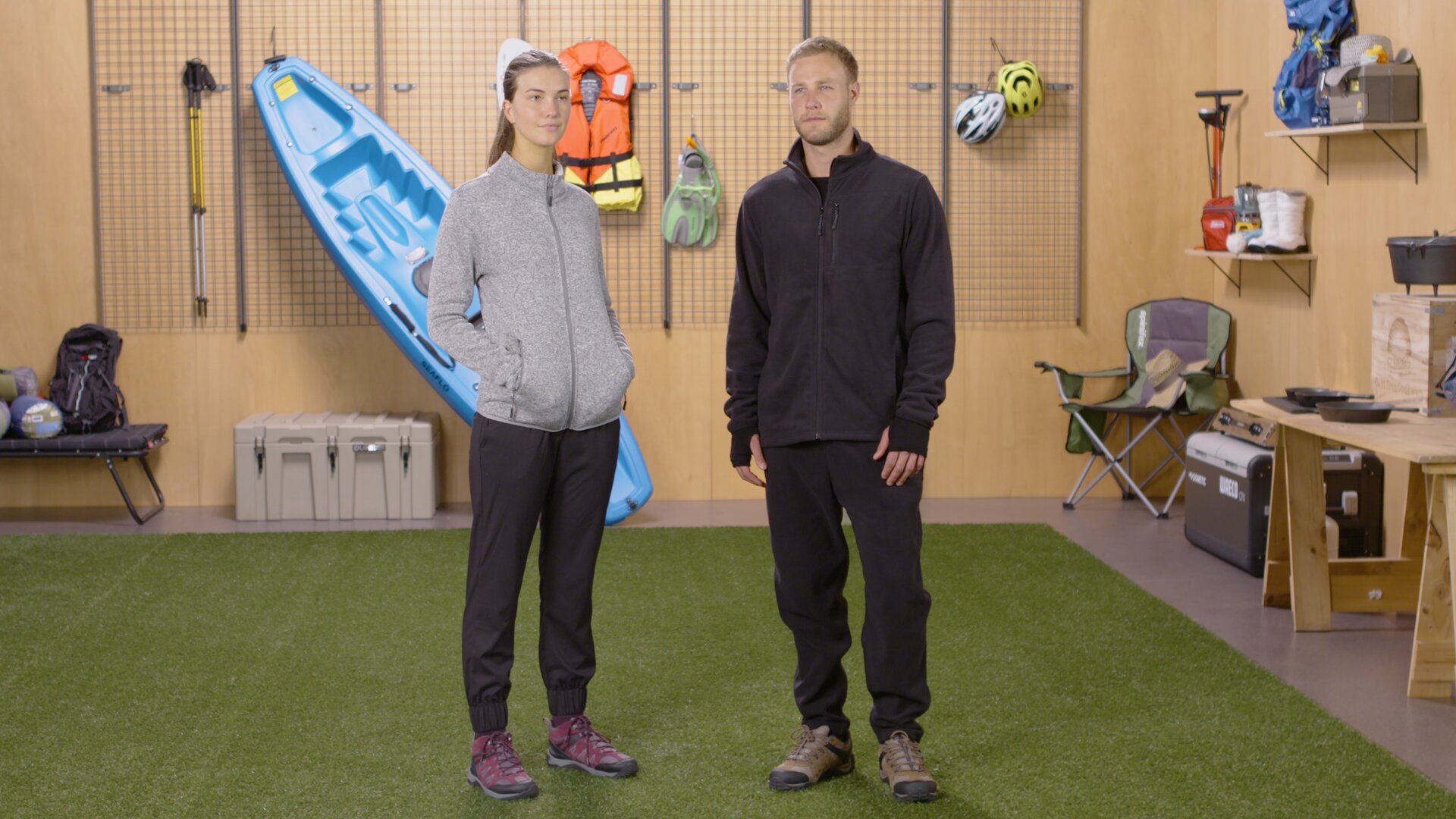| Your browser is not supported. | ||
|
Please browse our site using any of the following options:
| ||
How to choose base layers?
Whether you're hitting the slopes, camping, hiking or travelling in chilly conditions, you'll need the right clothing to ensure you're warm and happy, not cold and miserable. Wearing layers is the key to staying warm and comfortable, and this Buying Guide outlines the importance of wearing a base layer (or thermals). When you get dressed you put your thermals on first. Their job is to help keep your body warm, drawing moisture away from your skin so your sweat or standing still doesn't make you feel cold. This ensures your body temperature is comfortable in mild and ultra-cold conditions.
What's the best base layer?
When you're trying to work out which thermals will be best for you or the kids, remember that what's best for one person might not suit someone else.
Choosing the best base layer comes down to each individual's unique needs and preferences:
- The conditions you expect to face now and in future (what temperatures and will this vary?)
- How much you feel the cold in general (if you're always cold go for the warmest thermals)
- How often you'll be outside wearing your base layer (once a year or most weekends?)
- How active your adventures will be (will you be walking or working up a serious sweat?)
- How long you want your thermals to last (for one hike or ski season or for years to come?)
What winter clothes do you need to take to the snow?
Haven't been to the snow before and wondering "What should you wear when snow skiing?"
Working out which base layer you should buy is easier when you break it down into these five steps:

1. Layering Basics
When you're skiing, snowboarding, hiking, camping or kayaking, it's best to wear three layers:
A base layer
- Keeps you dry and stops body moisture making you feel cold.
- Draws (or wicks) sweat away from your skin to keep you dry.
- This stops body heat escaping via your sweat so you feel warm.
- Also helps prevent excess moisture causing chafing and blisters.
A middle layer
- Keeps you nice and warm by stopping body heat from escaping.
- Is put on after your thermals and before your waterproof layer.
- Acts as insulation by trapping any heat that's escaped past your thermals.
An outer layer
- Shields you from the elements you're exposed to-wind, rain and snow.
- This last layer is the final frontier to ensure you're dry and warm.
- Some jackets and pants are all-in-one outer layers and middle layers.
Any time you're inside you can shed layers, and then layer up before heading out again.
This Buying Guide is all about the base - the skin-tight layer you put on first to regulate your core body temperature so you don't feel too hot or too cold, but just right.
Why bother wearing a base layer?
Let's take a closer look at how wearing thermals helps you combat the cold and be comfortable.
Our bodies sweat when we're active to release heat (because water is really good at conducting heat) so we don't overheat. The problem with that, is when it's windy or cold, this can cause our core body temperature to drop quickly and even dangerously, and hypothermia is a serious risk in cold conditions. A base layer absorbs the moisture your body releases, wicking it away from your skin before it has a chance to cause your body temperature to drop. The moisture then makes its way through the next two layers and evaporates. So in a nutshell, thermals stop your body heat escaping via your sweat, keeping the cold at bay so you stay warm.
To effectively regulate your core body temperature, the base layer needs to be:
- Hydrophilic - the technical word for absorbent, so it absorbs your sweat fast.
- Hydrophobic - the technical word for quick-drying, so wet fabric doesn't make you cold.
- A snug fit - that feels like a second skin, but not so tight that it restricts your circulation!

2. Fit & Type
Your thermals need to be the right fit for your body, and the type needs to suit the conditions.
Thermals need to sit close to your skin to be able to wick moisture and trap heat:
- For maximum dryness and warmth, choose a snug-fitting size (but not too tight).
- They should feel tighter than a T-shirt - any looser and they won't do their job.
You can also get thermals with extra features so they're more comfortable:
- Flat-locked seams - stitching that sits flat against your skin to prevent rubbing and chafing.
- High, mid or low rise waists - for temperature regulation and your preferred comfort.
- An elastic waistband - feels more secure around your middle and is great for climbing.
- Gussets - extra padding on your underarms or inner thighs for comfort and mobility.
The type you choose depends on the weather conditions you'll face.
Sleeveless Vest
Gives your arms more freedom to move but not as warm as a thermal top with sleeves.
Short Sleeves & Legs
Keeps your core warm and dry but you won't get too hot, so best for warmer weather.
Long Sleeves & Legs
Keeps the full length or your arms and legs warm, so best for cold conditions.
3. Materials
The material the base layer is made from determines how warm, dry and comfortable you'll be.
Materials can be natural, synthetic or a mixture of both, and each fabric has different benefits.
Synthetic Materials
Thermals made from synthetic, man-made fabrics like polyester:
- Provide a lot of warmth and dry fast so suit snow activities.
- Can start to smell as your body odour seeps into the fabric.
- Some have an antibacterial treatment to help with odours.
Polypropylene
Polypropylene, which is often shortened to polypro:
- Is an ultra-comfortable, extra-warm engineered polyester that's superior to old long johns.
- Is hydrophobic so when sweat moves away from your body and into the fabric it dries fast.
- Wicks skin moisture away but only absorbs 1% of its weight before you feel damp and cold.
- Is thin and lightweight (70% lighter than wool) so good for layering without adding bulk.
- Is extremely hard wearing so polypro thermals last, are easy to wash and dry quickly.
Natural Materials
Thermals made from natural fabrics like merino wool:
- Are breathable so keep you at a comfortable body temperature in cold and warm weather.
- Provide better all-round comfort than thermals made from synthetic materials.
- Absorb more moisture than synthetic materials but take longer to dry.
- Don't absorb odours so you can pack light for camping and hiking trips without washing.
Merino Wool
Base layers made from merino wool:
- Are natural, breathable, warm and lightweight so they feel nice to wear.
- Create a microclimate so you're protected from weather changes and always comfortable.
- Are hydroscopic so they can absorb skin's moisture vapour and release it all at once.
- Absorbs up to 35% of its bodyweight in moisture before feeling damp so suits skiing.
- Will still keep you warm even when they're wet (but take longer to dry than polypro).
- Are antimicrobial so kill odour-causing bacteria during hiking and high-energy activities.
- Is an extra fine fabric so it feels lovely and soft against your skin while keeping you warm.
- The higher the wool density (thickness in g/m2) the warmer the fabric will make you feel.
Cotton
Cotton absorbs so much moisture it would make you feel cold, so it's not a viable base layer option for hiking and active adventures.
Synthetic/Natural Materials
Base layers made from a blend of polypro and wool combine the benefits of both materials:
- Warmth
- Breathability
- Dryness
Sun Protection
Fabrics with a UPF50+ treatment will protect your skin from the sun's rays, particularly if you're wearing your thermals by themselves in warm weather.

4. Activity & Conditions
Choose what to wear based on what you're doing and the weather conditions.
Activity Intensity
The more active you'll be in your gear, the more important its breathability is. If the fabric doesn't breathe, the moisture leaving your body has nowhere to go so you'll feel hot and sweaty, and your clothes can become a bit stinky.
The thermals you wear need to suit the type of activity you're doing:
- A lightweight base layer - best for stop-start activities like skiing or climbing.
- Heavier thermals - best for just camping and walking around in cold weather.
- Merino wool - best for low-moderate activities in the cold - warm and won't get smelly.
- Polypropylene - best for high-intensity activities like cross-country skiing and running.
- Long hiking trips - merino wool is best - it suits all temperatures and is odour-resistant.
- Bush hiking - be aware that merino wool is super fine so may tear if it snags on trees etc.
Weather
The fabric thickness of your thermals needs to suit the weather you'll encounter:
- Mild weather - a lightweight base layer is best for warmer weather.
- Cold weather - heavier thermals are better when it's extremely cold.

5. Quality
When you're weighing up which thermals to buy, think about quality versus cost:
- Synthetic fabrics like polypro are cheaper than natural fabrics like merino wool.
- Merino wool costs more than polypro because it's warmer, breathable and won't smell.
- Keeping the kids warm and dry will keep them happier in the snow for longer.
When it comes to how much you should spend on buying your base layer:
- Think about how long you want it to last/how long it'll fit your kids for.
- If you won't be using your thermals often, buying a basic base layer will do the trick.
- If you're keen on lots of hiking and outdoor adventures, it's worth investing in good quality thermals that will be comfortable and last years to come.
How much are thermals?
Anaconda has base layers for all budgets:
- Men's and women's thermals from $20-$100.
- Kids' thermals from $18 -$70.
When you go to the clothing section on the Anaconda menu, select men's, women's or kid's thermals from the dropdown menu. Then you'll see tick box filters down the left hand side of the page. Using these filters makes working out which base layer to buy easier and faster because you can choose to filter what you see by:
- Price - so you only see base layers within your budget.
- Deal - so you only see all thermals that are on sale.
- Size - so you just see thermals in the size you want.
- Colour - so you only see base layers in colours you like.
- Breathability - so you can see all the breathable thermals.
- Moisture wicking - so you only see thermals that help keep you dry.
- Wind proof - so all the thermals you're looking at are wind proof.
- Water proof - so you see thermals that are water resistant.
- Brand - so you can find specific brands you know and like.
Caring for your thermals
You want your thermals to last, so make sure you take good care of them:
- Wash your thermals at cold or low temperatures
- Dry them on a line or clothes rack. Don't iron or put them in the drier-they can shrink!
- Make sure they're completely dry before you put them away.
- Care instructions differ depending on the fabric, so always follow the label instructions.
Other Clothing Essentials
Check out Anaconda's range of Clothing available online or visit your local store.